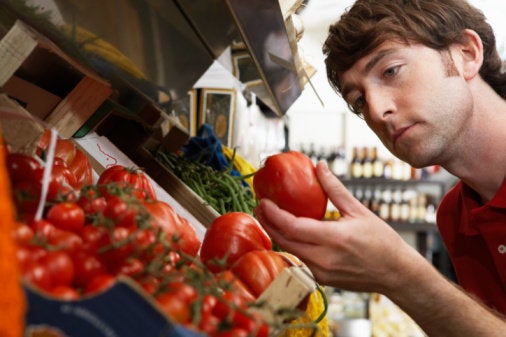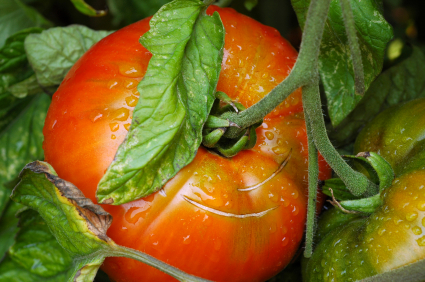

"I can't count the number of times someone has tasted one of my tomatoes or melons for the first time and said, 'This brings back memories of my childhood,'" says Amy Goldman, author of The Heirloom Tomato and two other books on heirlooms, one squash and the other melons. Their response is because the flavor is so refreshingly robust and vibrant.
The flavor of Amy's tomatoes is being compared to the gas-ripened, pinkish, mealy, and bland tasting industrial tomatoes we all know from iceberg lettuce salads and from what is available in supermarkets. The tomatoes people are referencing from their childhoods, if they are old enough, are freshly picked, fully red and ripe, juicy, and lusciously sweet yet slightly acidic.
This latter tomato is what I call the Slow Food tomato, because the Slow Food movement is about bringing the pleasure of food back into our lives in a way that also benefits the planet.
What better way to understand how Slow Food works than to look at the tomato? I've adapted here a section from the chapter on variety in True Food: 8 Simple Steps to a Healthier You, my new book with Melissa Breyer and Wendy Gordon. As you read, you'll begin to see how your choice of tomato makes a vital difference for the planet as well as your palette.
A Tale of Two Tomatoes
Tomato Seed One - F1 Hybrids
When you sit down to eat a salad with a tomato that you bought at a supermarket, chances are that the tomato was grown from an F1 hybrid seed, a seed that is not found in nature.
Breeders make F1 hybrids by first "selfing" plants -- making them reproduce by using the plant's own pollen - and then crossing two highly inbred parent lines. The resulting seeds yield uniformity, a trait desirable for industrial farms, which grow thousands of acres of one kind of food. The seeds are bred for large-scale food production, prizing yield per acre, uniformity of color and consistency, and pest resistance. Second generation seeds tend to be sterile, or do not breed true: Farmers have to buy new seeds every year, posing a serious problem for poor countries.
Because the tomato you bought is most likely identical to the tomato you will buy next month, you will not be getting a variety of nutritional benefits, as you would if you were eating different tomato types. Lastly, if all industrial farms around the country are growing F1 tomato plants, they are forcing out of the market the thousands of diverse tomato varieties that have, over the course of centuries, adapted to withstand drought, freezing, and blight.
In modern times, when difficult blights and fungi attack their F 1 hybrid plants, industrial farms use huge amounts of pesticides. Yet pesticide- and fungicide-resistant strains of plant diseases are developing all the time, making this a vicious cycle that poisons our food supply and the environment.
Tomato Seed Two- Open-Pollinated, Heirloom
To find a tomato or other plant that is genetically unique you most likely would have to go to a farmers' market or grow your own. Food grown from heirloom and open-pollinated seeds has now become that obscure. But the seed that grew the tomato you went out of your way to buy or grow is a cultivar that came from a seed passed down through countless generations. And at a farmers' market, you may be able to buy four or five tomatoes from different gene pools, giving you nutritional variety and a variety of tastes and flavors as well.
Open-pollinated seeds are constantly being modified in nature because the plants cross-pollinate with others in the locale -- called serendipitous crossing -- passing genes back and forth. The genes have been fine-tuned over centuries to a variety of climate and soil conditions, as well as adapting to blights and pests, making the plants uniquely capable of staving off a variety of threats.
It's also selection of favorable traits by generations of farmers and gardeners that has led to the domestication of all our major food crops. Seeds survived in this way for millennia before chemical sprays and fertilizers existed. Modern farmers who caretake heirloom seeds almost always grow them organically. Whereas often an heirloom seed will be native to a region, heirlooms do not necessarily imply native species -- immigrants have brought their seeds to the United States for years, and the seeds have been domesticated.
Alice Waters, owner and founder of Chez Panisse, notes in an interview with Sally Quinn for The Washington Post, that "the mantra of Slow Food is 'good, clean, and fair'." For her meals she finds food in season, when there is an aliveness and ripeness to it, and eats it very simply. I'm sure she wouldn't mind if I added "true" to the type of food she finds, as she wrote the Foreword to True Food, and I know she'd be voting for the heirloom tomato as part of her delicious Slow Food menus. If you garden, pick the heirloom tomato when you choose your tomato seeds and plants this year!